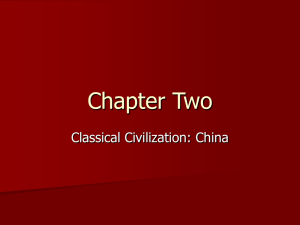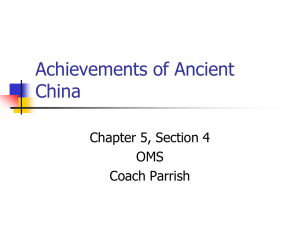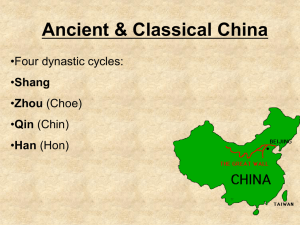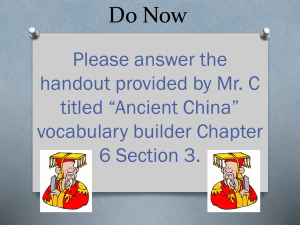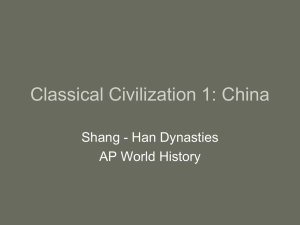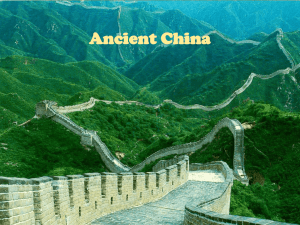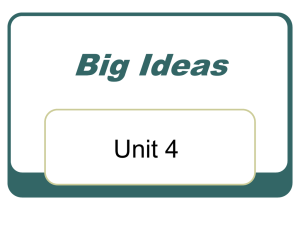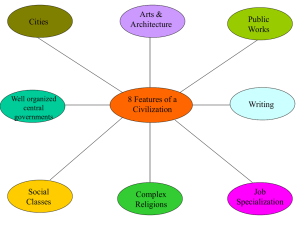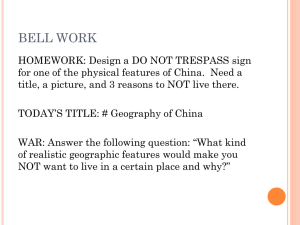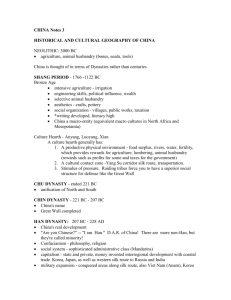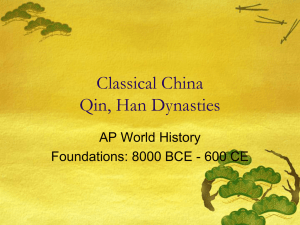Chapter 8 Ancient China
advertisement
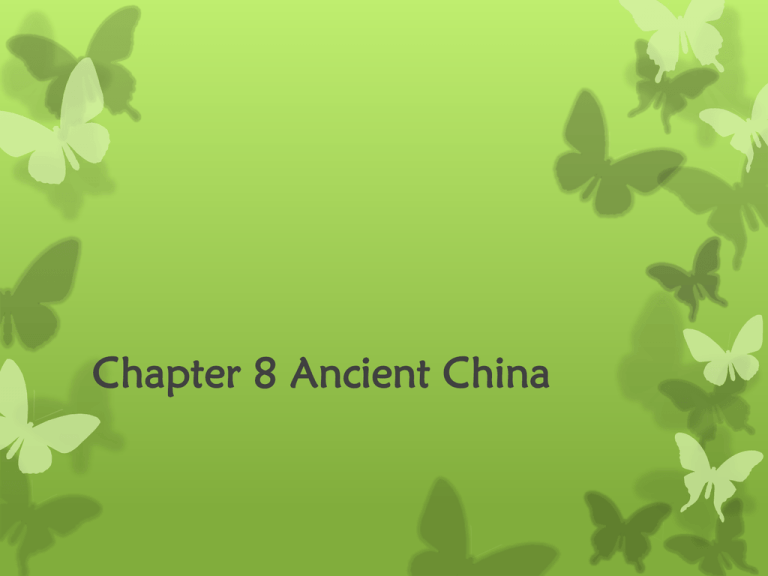
Chapter 8 Ancient China Geography Shapes Life in Ancient China Chapter 8 Lesson 1 Located on the Eastern side of Asia Lies about same latitude lines as United States Bordered on the east by the Yellow Sea, East China Sea, and the Pacific Ocean Deserts edge the northern and western lands. • North—Gobi Desert • West—Taklimakan Desert Mountain ranges form tight curve on western border • Pamir, Tian Shan, and Himalaya mountains. Isolated by Barriers Did not interact with other civilizations because geographically separated from other civilizations because of: • Mountain ranges • Deserts • Large bodies of water Made spread of ideas difficult Two River System Chang Jiang/Yangtze located in central China Huang He/Yellow River is located to the north Both deposit yellow silt Farming done between the two rivers—area called North China Plain A Varied Climate Western China: dry like Western United States Northern China: like New England (Maine, New Hampshire, Connecticut, etc.) • Wheat and millet grown in the drier northern lands Southeast China: like southern United States • Rice grown in the moist climate Shang Dynasty Around 2000 B.C. farming settlements along the Huang He grew into cities. The beginning of Chinese culture developed. China is the oldest, longest lasting civilization in the world! Shang Kings Dynasty: line of rulers from the same family 1766 B.C. Shang family started to rule some cities. Kings were responsible for religious activities. Claimed to rule with gods’ permission Controlled central portion of North China Plain Relatives ruled distant areas Protected themselves from nomads, the Zhou, to the North and west with chariots. Shang Families Respect for family and ancestors very important Family was closely tied to religion Believes spirits of ancestors could bring good fortune to family Family paid respect to father’s ancestors by making animal sacrifices Men were in charge of the family Developing Language Oracle bones—animal bones or turtle shells on which Shang royal priests used to interpret messages from the gods. Priests would make scratch marks on bones and shells—early form of writing Developing Language Continued… Pictograph system of writing developed Used simple drawings/symbols for words or ideas To barely be able to read and write must know at least 1,500 Characters in the Chinese alphabet Scribe needed to know 10,000 characters The Zhou Dynasty 1027 B.C. the Zhou ruler, Wu Wang, defeated the Shang dynasty. A new dynasty was started. Adopted many Shang ways and started the pattern of Chinese culture. Dynastic Cycle 1. Mandate of Heaven: The people believe the new dynasty has the gods’ approval The new dynasty restores peace and order. The dynasty’s power grows weaker The dynasty is overthrown. Disasters such as floods, famines, and invasions occur. The people believe the dynasty has lost the gods’ approval Zhou Government Did not have strong central government. Family members or trusted friends were put in control of regions Regions owed military service to the Zhou king, and the king would protect their lands. As cities grew lords became more powerful and fought against themselves to expand Chinese territory. The Time of the Warring States 800 B.C. Invaders killed the Zhou king, but the Zhou family escaped and set up a new capital. The Warring States: Starting around 403 B.C., Lords and regions fought constantly due to the fact the Zhou kings were weak. China’s Ancient Philosophies Chapter 8 Lesson 2 Legalism Philosophy: study of basic truths and ideas about the universe Legalism: a belief that rulers should use the legal system to force people to obey laws These people believed a strong government was the answer to China’s problems. Strict Laws and Harsh Punishments Legalists’ beliefs: • Human nature is naturally wicked, and people must be forced to do good. • Government must pass strict laws to control the way people behave • Harsh punishments make people fear doing wrong. An Increase of Government Control Shang Yang wanted people to turn in others who broke the law. He thought that people who did not report lawbreakers should be punished. Legalists: • thought those who did their duty should be rewarded. • did not want people to complain about government. • Favored arresting people who questioned the government or taught different ideas. • Thought rulers should burn books that contained different philosophies or ideas. Confucianism Lived 551-479 B.C. Developed ideas to end conflict and have peace in all relationships Believed: • respect for others was absolutely necessary for peace and harmony • Government leaders should set a good example Students collected Confucius’ teachings and ideas to make book called the Analects which Confucianism is based. The Five Relationships Confucius created code of proper conduct for people. Each relationship has its own duties and own code of conduct. Father and Son Elder Brother and Junior Brother Husband and Wife Relationships fall under two categories: • Proper conduct in the family • Proper conduct in society Friend and Friend Ruler and Subject Proper Conduct Society Authority should be respected. Ruler should lead in a right, moral way and subjects will obey. Ruler should treat subjects with respect. Family Confucius believed respect and good behavior started at home. Filial Piety—respect for one’s parents and ancestors The Impact of Confucianism Confucianism set out clear family and social roles. Chinese found ways to avoid problems and live peacefully. Many rulers tried to follow philosophy. By encouraging education, Confucius laid groundwork for fair and skilled government officials. Daoism & The Way Is said to be started with Laozi, “Old Master”. Book of teachings called Dao De Jing (The Book of the Virtue) Believes “The Way” or Dao guides all things. All creatures except humans follow Dao Humans must learn to live in harmony with nature and with their inner feelings to find the way. Following the Way Daoists accepted things as they were. Did not become involved with government Tried to understand nature and live in harmony with it. Yin Yang: two things that interact with one another • Yin (black): all things cold, dark, and mysterious • Yang (white): all that is warm, bright, and light. • Compliment each other • Helps people understand how the fit into the world. The Qin and the Han Lesson 3 The Qin Unified China—A Legalistic Ruler New ruler came from state of Qin New emperor -- Shi Huangdi Stopped battles within warring states. Co Conquered rival states Drove out nomadic invaders China grew the largest it had ever been! A Legalistic Ruler Continued… Shi Huangdi didn’t believe in Confucian teachings Killed 460 government critics and Confucianists Ordered burning of books that had ideas he disliked. Uniting China Wanted total control of China: • Took land away from defeated noble families • Forced nobles to live at the capital so he could watch them • This weakened noble families’ power. Shi Huangdi build highways and irrigation projects. • Forced peasants to work on projects • Set high taxes for peasants to pay Made a standard measure of weights, coins, and writing to unite the country. The Great Wall of China Shi Huangdi planned the Great Wall along the northern border to keep out invaders. Thousands of peasants and criminals forced to build it. Many died and the people resented the emperor. Great Wall linked many small walls that were built during the time of the Warring States. Earliest walls built of earth, later stone and brick were used. The Qin Dynasty Ends Shi Huandi died in 210 B.C.E. Created an elaborate tomb with terra cotta soldiers. Archeologists discovered the soliders in 1974 Han Dynasty The Han Dynasty began in 202 B.C.E. after Liu Bang defeated the Qin forces. Han Government Liu Bang kept Qin policies of central government, but lowered taxes. Made punishments less harsh. Peasant men owed the government a month of labor/work a year on government projects. Peasants built roads, canals, and irrigation projects. Han Government Cont… Bureaucracy: network of appointed officials that assist in government Officials helped Liu Bang enforce rules. Bureaucrats put family members and trusted people in local government positions. Set up a system of tests to find the most educated and ethical people for the imperial bureaucratic state. • Tested people on their knowledge of Confucianism. Empress Rules Liu Bang died 195 B.C. Widow, Empress Lu took the thrown for their young son. Outlived son and continued to put babies on the throne so she could rule for them. When she died in 180 B.C. all her family members were killed. Expanding the Empire Wudi (descendent of Liu Bang) ruled the Han empire from 141-87 B.C.E. Made many military conquests including southern Chinese provinces, northern Vietnam, and northern Korea. Chased nomadic invaders out of northern China China was almost as large as modern day China. The Han empire faced rebellions, peasant revolts, floods, famine, and economic disasters, but stayed in power until 220 C.E./A.D. Daily Life in Han China Majority of society lived and worked on farms. Farmers lived in one to two story houses in villages near their farm. Barns, pigsties, and storage buildings were located in the village. Rich farmers had ox to pull their plows while poor farmers had to pull the plows themselves. Daily Life in Han China Cont… Farmers wore simple clothing and sandals like today. Clothing was stuffed like quilts for colder weather. Northern farmers grew wheat or millet. Southern farmers grew rice. Families kept vegetable gardens for additional food. Fish and meat were expensive so people ate small portions. City Living Cities were centers of trade, education, and government. Merchants, craftspeople, and government officials lived in the city. Cities were crowded and had lots of entertainment • Included musicians, jugglers, and acrobats Some cities had street gangs. The Legacy of Ancient China Chapter 8, Lesson 4 The Silk Road Only Chinese new how to make silk during the Han dynasty. Silk is a luxury fabric around the world. A Trans-Eurasian Link Silk Roads: land trade routes that people took to trade silk and other goods on caravan trails. Trails stretched from China to central Asia to Mesopotamia to Europe. Trans-Eurasian: stretched across two continents and part of global trade network. Goods leaving China included: • Silk • Paper • Pottery Goods exchanged from the west included: • Sesame seeds and oil • Metals • Precious stones • horses Cultural Diffusion Cultural Diffusion: the spread of ideas and customs Cultural diffusion also was traded on the Silk Road. For example: • Military methods • Buddhism • Western cultural styles • Art • Silks • pottery The Spread of Buddhism During Han Dynasty Buddhist monks took the Silk Road spreading the religion to China, Japan, and Korea. Chinese Buddhists modified the religion to fit their traditions. Influential Ideas and Beliefs Confucianism Daoism Confucianism remained important in Chinese government and education. Had a lasting influence. Ideas about social duty are still important to villages. Became influential philosophy in Japan, Korea, and Vietnam. By 6th century became religion with priests, rituals, and volumes of writings. Remained primarily a Chinese belief. Chinese Inventions and Discoveries Agricultural Improvements Silk The plow and farm tools increased crop production China lacked gold and silver. For example: Important to trade silk for this scarcity • Collar harness • Wheelbarrow • Better plow • Watermill Paper Books used to be made out of silk. 105 A.D./C.E. paper was invented by china Made it less expensive for everyone. Important in a culture that valued learning. Silk is can be dyed brightly and is long lasting. 1 lb. silk equals 1 lb. of gold/silver

